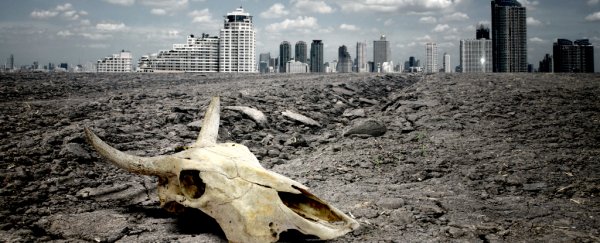As our population skyrockets towards 9 billion, a group of researchers in the UK think the only way we can realistically keep up with building demands is to look to materials like artificial bone to construct the cities of the future.
While the idea of living inside a 'bone skyscraper' might sound terrifying, right now, concrete and steel are responsible for 10 percent of worldwide carbon emissions. Instead, natural materials such as bone and eggshell manage to achieve similar strength with far less resources.
A team from the University of Cambridge is now studying these materials further to try and figure out whether we can mimic the process to create our own bone-like materials as efficiently as the human body.
"What we're trying to do is to rethink the way that we make things," says team leader and bioengineer Michelle Oyen. "Engineers tend to throw energy at problems, whereas nature throws information at problems - they fundamentally do things differently."
Her lab has already created artificial bone and eggshell in the lab in small doses, but the process can be done at room temperature and is cheap, energy efficient, and easy to scale up, she explains.
They do this by taking animal collagen - the most abundant protein in the world - and then simply templating on layers of minerals.
The 'bone' they've created is pretty much made up of equal portions of mineral and protein - the mineral gives the bone stiffness and hardness, while the protein makes it more resistant to fracture.
The artificial eggshell, on the other hand, has around 95 percent mineral to 5 percent protein, which means it's thinner and lighter, but also more fragile.
But the real benefit, could come from layering the two materials. "One of the interesting things is that the minerals that make up bone deposit along the collagen, and eggshell deposits outwards from the collagen, perpendicular to it," says Oyen.
"So it might even be the case that these two composites could be combined to make a lattice-type structure, which would be even stronger - there's some interesting science there that we'd like to look into."
Unfortunately, it's probably going to be a while before these materials are ready to hit the construction industry - for starters, using animal collagen isn't the most eco-friendly option, and the researchers are hoping to replace this with artificial collage in the future.
The building industry also isn't ready for a fundamental change just yet. "All of our existing building standards have been designed with concrete and steel in mind. Constructing buildings out of entirely new materials would mean completely rethinking the whole industry," says Oyen.
One of her colleagues, Michael Ramage, is trying to get this rethink started, by working on the plans for an 80-storey, 300-metre-high wooden skyscraper proposed to be built in London.
Currently, the tallest wooden building is a 14-storey apartment building in Bergen, Norway, but even though cutting down trees to make buildings isn't the best option, Ramage explains that this is still considerably better for the environment than traditional materials.
"What needs to be delivered in five trucks for a concrete building can be delivered in one truck for a timber building," he says. "That's an incredible advantage, for cost, for environment, for traffic and for cyclists."
"The material properties of bone and wood are very similar," added Oyen.
While Oyen and her team have published various papers on their artificial bone and eggshell materials, there's no peer-reviewed article just yet on how feasible these composites will be for large-scale building projects, so for now we're taking their word for it.
But whichever way you look at it, investigating alternatives for the buildings of the future is a good idea. "Just because we can make all of our buildings out of concrete and steel doesn't mean we should," says Oyen.
